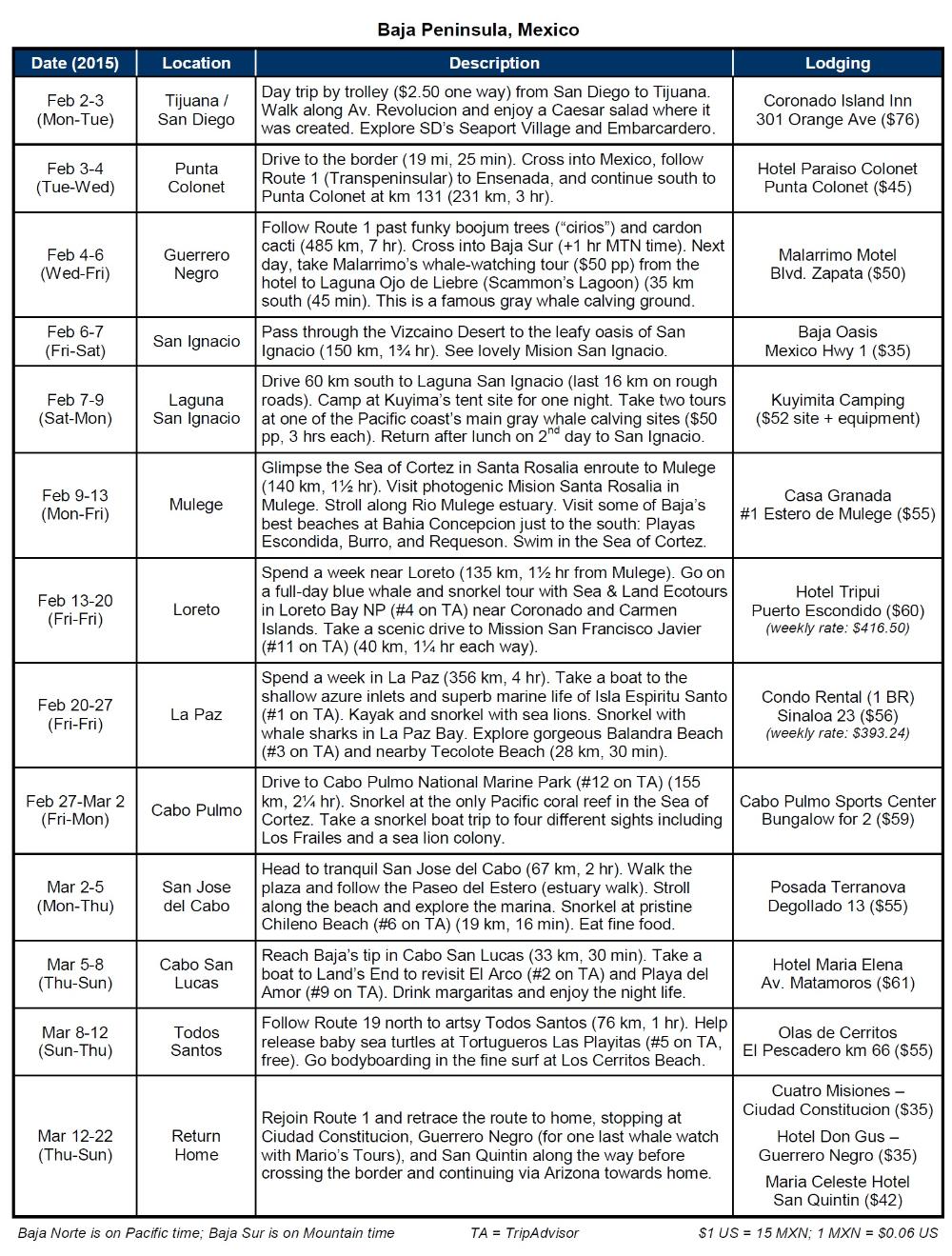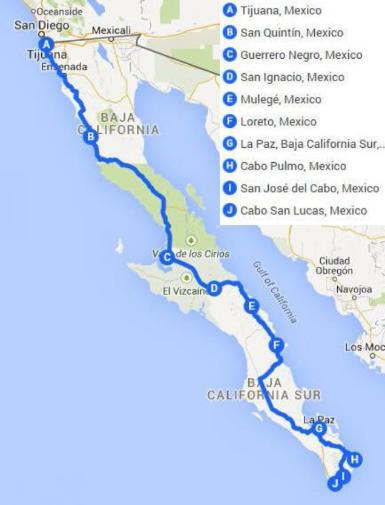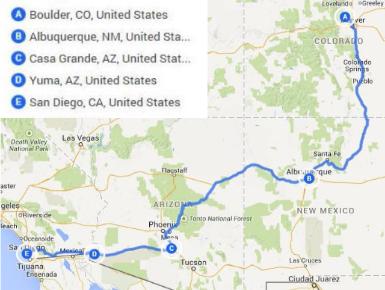
Where We Be



| Our Baja Itinerary |
| Our Pre-Baja Itinerary |
| Just getting from Boulder to San Diego covered 1,300 miles (2,000 km) one way |
| Our route through Baja covered 1,100 miles (1,780 km) one-way. That's 22 hours nonstop -- but of course we stopped plenty during our 1½ months in Baja. |
| BAJA TIPS |
Driving in Baja: A 4WD or high-clearance vehicle is a huge plus in Baja.
Dirt and gravel roads to places like San Ignacio Lagoon and Cabo Pulmo
are manageable in a regular passenger car, but just barely. You won't
want to do the whole East Cape Road in a regular car -- just the 10 km to
Cabo Pulmo took forever. That said, Route 1 itself is paved the whole way.
Just about no one drives the speed limit in Baja. Posted limits are often
surprisingly low. We decided to just use common sense and do what those
around us were doing: drive between 10 and 20 kph faster than most of
the posted limits on the open highway. We were always careful to obey
posted limits when passing through towns.
We had no issues with police targeting us or pulling us over during our trip
despite what we'd heard beforehand. (The internet can scare you silly!) In
fact we barely saw police in terms of speed traps, etc.
Truckers often use their left turn signal to indicate it's safe to pass them.
Be careful, though -- sometimes they really are turning left.
"Topas" are speed bumps -- watch out for them, as some are large. You
can count on them being at the entrance and exit to each town.
Security checkpoints are part of the routine here, so don't freak out.
Typically they just ask you where you've been and where you're going. If
you don't speak Spanish, a good guess would be to say the name of the
town you stayed at last night and the one you're going to next.
Don't let your gas tank get much below half since there are long stretches
with no gas stations and sometimes in smaller towns they run out. Check
to be sure the gas pump is zeroed out by the attendant before he begins
pumping. There's no self-service gas. A tip of about 5% is appreciated.
Even a major street or destination may be unsigned in Baja, so if an
unmarked turnoff feels right and is where you expect it to be, take the
turn. Note: there is sometimes a pullout to the right in order to turn left.
If a street light is out, treat it as a four-way stop, just as you would in the
US. You'll do a lot more four-way stopping than you're used to back home.
Dirt and gravel roads to places like San Ignacio Lagoon and Cabo Pulmo
are manageable in a regular passenger car, but just barely. You won't
want to do the whole East Cape Road in a regular car -- just the 10 km to
Cabo Pulmo took forever. That said, Route 1 itself is paved the whole way.
Just about no one drives the speed limit in Baja. Posted limits are often
surprisingly low. We decided to just use common sense and do what those
around us were doing: drive between 10 and 20 kph faster than most of
the posted limits on the open highway. We were always careful to obey
posted limits when passing through towns.
We had no issues with police targeting us or pulling us over during our trip
despite what we'd heard beforehand. (The internet can scare you silly!) In
fact we barely saw police in terms of speed traps, etc.
Truckers often use their left turn signal to indicate it's safe to pass them.
Be careful, though -- sometimes they really are turning left.
"Topas" are speed bumps -- watch out for them, as some are large. You
can count on them being at the entrance and exit to each town.
Security checkpoints are part of the routine here, so don't freak out.
Typically they just ask you where you've been and where you're going. If
you don't speak Spanish, a good guess would be to say the name of the
town you stayed at last night and the one you're going to next.
Don't let your gas tank get much below half since there are long stretches
with no gas stations and sometimes in smaller towns they run out. Check
to be sure the gas pump is zeroed out by the attendant before he begins
pumping. There's no self-service gas. A tip of about 5% is appreciated.
Even a major street or destination may be unsigned in Baja, so if an
unmarked turnoff feels right and is where you expect it to be, take the
turn. Note: there is sometimes a pullout to the right in order to turn left.
If a street light is out, treat it as a four-way stop, just as you would in the
US. You'll do a lot more four-way stopping than you're used to back home.
Key Phrases: hola = hello; gracias = thank you; buenos dias = good day;
efectivo = cash; la cuenta = the bill; por favor = please.
Best Time to Go: We absolutely loved going in February and March, a
time that is rich with marine life -- including gray whales and their babies,
whale sharks, and turtle hatchlings. Temperatures are comfortable, and
swimming / snorkeling is definitely an option the further south you go.
Lodging: Wifi is commonplace -- we had it everywhere except San Ignacio
Lagoon and Cabo Pulmo. Note that almost no lodgings in Baja have heat.
We brought throw blankets in our car just in case but didn't need them
much. AC becomes more important the further south you go (depending on
the time of year). We were usually fine in Feb-Mar with just a fan.
Money: Tijuana offers surprisingly good exchange rates for changing US
dollars into pesos. US dollars are accepted nearly everywhere in Baja but
at a slightly unfavorable exchange rate, so it's better to get pesos for a
longer trip. Banks in bigger cities tend to offer the best exchange rates.
Don't assume the ATM's highest listed peso amount is the most the ATM
will dispense: try manually entering 7,000 pesos -- that's about $500 US at
current exchange rates, and it worked for us more than once (assuming
your own bank limit is that high).
You may want to bring extra US cash as a backup in case local ATMs run
out of money. It's also best to limit your ATM withdrawals to banks and large
supermarkets. ATMS on the street (especially ones dispensing US dollars)
can be susceptible to tampering.
Many (but not all) hotels, gas stations, and supermarkets take credit cards.
Tourist Visas: A tourist visa good for up to 180 days is available at border
crossings and costs $25 per person (as of 2015). A tourist visa is required
for each person if you're planning to travel further south than Ensenada.
You DON'T need a vehicle import permit for Baja-only travel.
Other Tips: Carry TP for public bathrooms. It's good to keep one or two
coins handy in case there's a small fee to use a public restroom.
efectivo = cash; la cuenta = the bill; por favor = please.
Best Time to Go: We absolutely loved going in February and March, a
time that is rich with marine life -- including gray whales and their babies,
whale sharks, and turtle hatchlings. Temperatures are comfortable, and
swimming / snorkeling is definitely an option the further south you go.
Lodging: Wifi is commonplace -- we had it everywhere except San Ignacio
Lagoon and Cabo Pulmo. Note that almost no lodgings in Baja have heat.
We brought throw blankets in our car just in case but didn't need them
much. AC becomes more important the further south you go (depending on
the time of year). We were usually fine in Feb-Mar with just a fan.
Money: Tijuana offers surprisingly good exchange rates for changing US
dollars into pesos. US dollars are accepted nearly everywhere in Baja but
at a slightly unfavorable exchange rate, so it's better to get pesos for a
longer trip. Banks in bigger cities tend to offer the best exchange rates.
Don't assume the ATM's highest listed peso amount is the most the ATM
will dispense: try manually entering 7,000 pesos -- that's about $500 US at
current exchange rates, and it worked for us more than once (assuming
your own bank limit is that high).
You may want to bring extra US cash as a backup in case local ATMs run
out of money. It's also best to limit your ATM withdrawals to banks and large
supermarkets. ATMS on the street (especially ones dispensing US dollars)
can be susceptible to tampering.
Many (but not all) hotels, gas stations, and supermarkets take credit cards.
Tourist Visas: A tourist visa good for up to 180 days is available at border
crossings and costs $25 per person (as of 2015). A tourist visa is required
for each person if you're planning to travel further south than Ensenada.
You DON'T need a vehicle import permit for Baja-only travel.
Other Tips: Carry TP for public bathrooms. It's good to keep one or two
coins handy in case there's a small fee to use a public restroom.
| Map data ©2015 Google |
| Map data ©2015 Google |